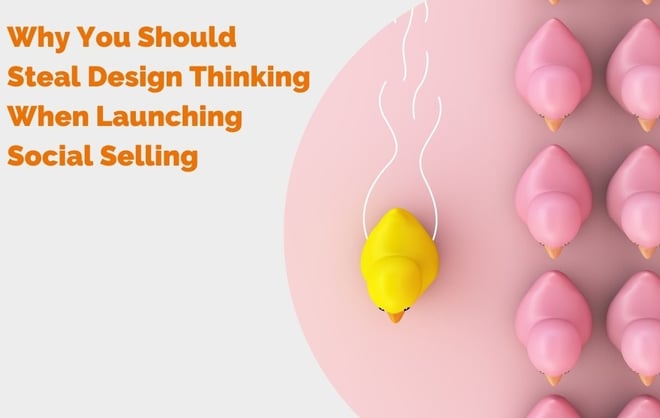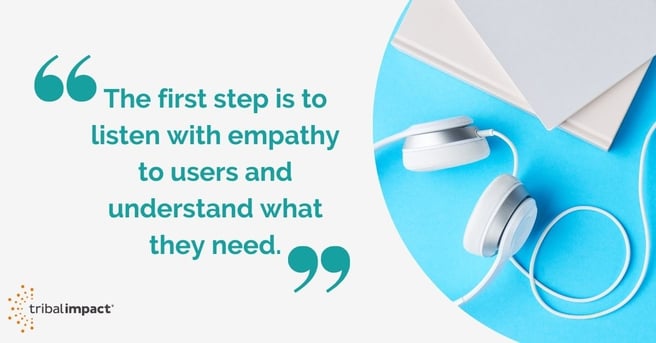
What comes to your mind when you hear the term ‘design thinking’?
Perhaps a picture of Silicon Valley geeks working in a fancy office on the latest innovation in the tech world.
If that’s the case, you might be wondering what it has to do with launching social selling enablement programs?
Grab some popcorn and allow me to explain!
Sales enablement programs of various kinds are often created with the help of Learning and Development professionals. We (yup, I am one of them) know for well that in order for our final solutions to meet our learners and business needs we need to think like designers.
What this means in practice is that when planning a learning experience, we first spend significant amount of time understanding the audience, their challenges and the wider business requirements before we design a solution. This solution is then often tested a small scale first to gather more insights on what works, instead of announcing to the world a solution we assume was best.
The LinkedIn Sales Navigator Community has recently invited me to discuss how this approach can help when launching social selling programs. Below are some thoughts and information that I shared with their audience.
Design thinking is an iterative, human-centred approach to problem solving that helps people and organisations be more creative. It involves empathising with your users’ needs and challenges first and then testing and optimising a working prototype (or a pilot) before delivering it at scale.
“Design thinking begins with skills designers have learned over many decades in their quest to match human needs with available technical resources within the practical constraints of business. By integrating what is desirable from a human point of view with what is technologically feasible and economically viable, designers have been able to create the products we enjoy today. Design thinking takes the next step, which is to put these tools into the hands of people who may have never thought of themselves as designers and apply them to a vastly greater range of problems.” – Tim Brown, Change by Design, Introduction
There are five stages of Design Thinking, according to Hasso-Plattner Institute of Design at Stanford (also known as d.school):
- Empathise with your users
- Define your users’ needs, their problem, and your insights
- Ideate by challenging assumptions and creating ideas for innovative solutions
- Prototype to start creating solutions
- Test soloutions
However, even once you launch a solution, the process is never done. There will always be issues and new challenges for your end users that need to be solved!
Step 1: Empathise
The first step is to listen with empathy to users and understand what they need. At Tribal, this is probably the most crucial step because every client and team has different problems, starting points and end goals.
With social selling enablement, it may be that a company comes to us and says, "We've given our employees access to Sales Navigator but they're not using it.” Or it could be that their employees are using it but they’re not getting the results they want, such as their expected increase in pipeline value or sales.
Those are two very different scenarios, but even then, there could be many causes. We therefore immerse ourselves in the organisation and spend a lot of time looking at the data and speaking with the users. This allows us to develop the best possible understanding of their needs and underlying problems.

Step 2: Define
The next stage of design thinking is to analyse all the information available and define the gaps between where the organisation and users are now versus where they want to be.
The gap could be knowledge. In the scenario where people aren't using Sales Navigator, they may not have received training or it may not have been easy to understand.
It could be a skills gap. They may have given their employees the knowledge but not provided enough time to practice, or perhaps further guidance when doing so, to help them use it in the best possible way.
Or it may be a gap in motivation, a gap in the environment, or a gap of habits, where they’ve simply not got into a routine of using the tool regularly to make the most out of it.
We then define exactly what the problem is but, as design thinking has empathy at its core, it’s done so in a human-centric way.
Step 3: Ideate
Once we’ve defined what those gaps are, we can then develop possible solutions that we can test.
Even though we have successful blueprints of what's worked before in other organisations, we still need to brainstorm with our clients to determine what will give the most impact. It’s very much a collaborative process.
For example, if the problem is a knowledge gap, at Tribal we have a philosophy, “Train the Masses, Train the Many, Train the Few”. It’s a blended learning approach that uses eLearning to help scale training across organisations and act as a reference point in their hour of need. We then deliver increasingly more targeted and practical training, moving towards practical workshops to one-to-one coaching. I believe there’s a big difference between giving people information and how they then put that into practice.
The solutions we brainstorm will depend on the gap between where an organisation’s users are on their social media journey and want to be as well as their preferred learning styles. All of this can affect the training topics, how it’s delivered, when it’s rolled out and to whom.
The ultimate goal of social selling enablement isn’t just about enabling the end-users but enabling the organisation to deliver that training. In enterprise organisations, they often have the resources to take the training in-house eventually but there's a knowledge gap of how to do so. This is where Train the Trainer or Coach the Coach would come in.

Step 4: Prototype
We use a pilot program as our working prototype with social selling enablement programs (or any training program rollout).
Pilots allow us to test ideas with a small group of people to see what works and what doesn’t. That way, we can tweak the potential end training solution before rolling it out to the whole organisation.
It doesn’t just save money – it helps ensure that employees will be excited about the program. The glitches have been ironed out that would otherwise have led to frustrations and low take-up. And, just as importantly, we now have stories and data that help get people on board.
Salespeople are quite competitive. They've got their targets linked to bonuses, so if they see that somebody else is doing it, the FOMO (fear of missing out) starts kicking in! If one of your pilot users has a great story of how they've managed to increase their sales pipeline, it creates healthy competitions. Salespeople will want to know what that person is doing that they're not and understand how they can do it, too.
Recommended reading: Why A Pilot Is A Must-Do For Social Business Transformation
Step 5: Test
We're continually testing what works and what doesn't during the pilot program using the data and feedback. Once we roll out the social selling enablement program to the whole organisation, the testing doesn't stop there moving forward. All of this helps to shape the version of the program that will be rolled out to a wider group of learners.
We’ll constantly review metrics to establish who is engaged with the program, what the top performers are doing differently and whether the training needs to be adapted or delivered in a different way.
Design Thinking is a constant process of iterative improvements based on what works for the end-users, so there will always be some issues that need tweaking or changing. And as users grow in their social selling journey, there may be other areas they want to explore with additional help. That’s the beauty of it. The human-centric and solutions-based approach to problem-solving is never satisfied with the status quo. It's a growth mindset approach to Learning & Development!




